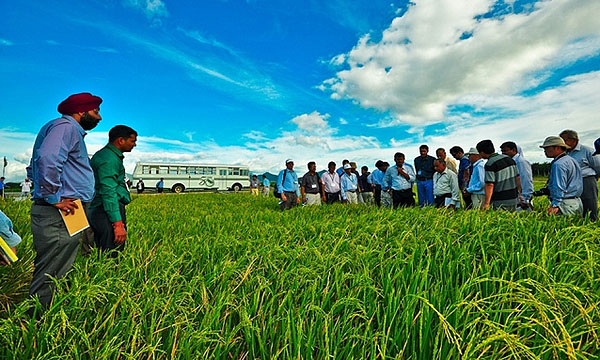
Hybrid rice has the potential to produce up to 30% more yield than the best-performing modern inbred varieties, thanks to A hybrid history vigor or heterosis. In 2011, the media reported that, on a test plot in Hunan, China, an output of 13.9 tons per hectare had been achieved—potentially setting a new world record. Such is the potential of hybrid rice varieties to feed the world and its ever-growing population.
Heterosis for the tropics
Success in temperate hybrid rice accelerated research and development in tropical hybrid rice. This can be attributed to the Hybrid Rice Development Consortium (HRDC).
The International Rice Research Institute (IRRI) took the lead in developing the technology for tropical rice-growing countries, and now several hybrids from the public and private sector are released and commercialized in India, the Philippines, Vietnam, Bangladesh, and Indonesia.
Breaking the limits
The HRDC continues to push the yield potential of tropical hybrid rice. In 2011, the Consortium released three IRRI-bred tropical hybrids in the Philippines: Mestiso 30, Mestiso 31, and Mestiso 32.
“These varieties have an average yield of 6.93 tons per hectare,” said Fangming Xie, hybrid rice breeder at IRRI and HRDC coordinator. “This is 6.5% higher than the average yield of 11 other Philippine hybrid varieties released in 2011.”
New research on tropical hybrid rice is also under way, including increasing hybrid seed production; disease resistance; stress, drought, and flood tolerance; and better grain quality, among others.
Latin hybrids
Halfway across the globe, the International Center for Tropical Agriculture (CIAT) is also exploring hybrid rice technology as a new approach to increase rice productivity in Latin America.
CIAT field-tested its first 19 experimental hybrids from basic germplasm from IRRI. The Center is looking for hybrids with high heterosis, resistance to diseases, good grain quality, and high suitability for the tropical conditions of many Latin American countries.
“The results show some hybrids, such as CT23057H, with good potential to be commercial products,” said Edgar Torres, plant breeder with CIAT’s Rice Program and the Latin American Fund for Irrigated Rice (FLAR).
“More trials are being conducted by FLAR partners in Brazil, Argentina, Uruguay, Colombia, Panama, Nicaragua, Costa Rica, and the Dominican Republic,” he added.
Widening the network

The HRDC not only strengthens its hybrid rice research and development at IRRI but also focuses on its collaboration and network with private and public partners, thus expanding research areas with more products and bringing new resources, as well as valuable experience, to the hybrid rice community. In 2011, the HRDC had a total of 59 partners, up from only 38 in 2008.
“The hybrid rice products developed by the HRDC, including more than 3,500 IRRI hybrid rice breeding germplasm accessions and hybrid rice parents, have been shared with Consortium members and the international hybrid rice community,” Dr. Xie reported. “This partnership enhances the steady stream of innovation and improves product accessibility and commercial use ultimately by rice farmers.”
Dr. Torres acknowledges the importance of sharing in making tropical hybrid rice a commercial reality. “The increased germplasm interchange with the HRDC has enabled us to produce hybrids with higher yield and good grain quality,” said Dr. Torres. “The collaboration effort between IRRI and CIAT is targeting the development of new technology relevant for the rice farmers in Latin America.”
The future of tropical hybrids
The international hybrid rice community has grown rapidly in just 3 years. Where does it go from here? Dr. Yuan Longping, the “Father of Hybrid Rice,” is determined to develop a super high-yielding hybrid rice that could bring average yields to 15 tons per hectare by 2020 (see related story Q and A with the Father of Hybrid Rice). In time, through the sharing of germplasm, knowledge, and experience, researchers working on tropical hybrid rice could shoot for the same.








